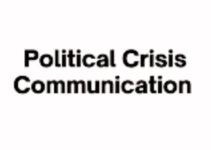Online crisis communication is the method of employing multiple digital and online media channels during emergency and disruption situations. The online and digital media channels are quick, speedy, and efficient for sharing and distributing information to the media and public. Today, we’ll discuss online crisis communication; digital media channels, steps involved in building the strategy, and key elements of crisis communication.
Online Media Channels
- Social media platforms
- Influencers
- Websites
- SEO (search engine optimization)
- Content Marketing
- Pay-per-click
- Affiliate Marketing
- Referral marketing
- Video Marketing
- Paid searches
Building Online Crisis Communication Strategy
- Recognizing and allocating crisis response team members
- Setting up priority guidelines
- Scheduling and recognizing posting platforms
- Building an internal crisis communication plan
- Carefully listening to the reviews and feedback of customers
- Streamlining crisis plan with the digital policy of the company
Key Elements of Online Crisis Communication
Some of the key elements of the online crisis communication strategy; they’re as follows;
Automation Tools and Software
There are various automation tools and software that would help you to be aware of the various events relevant to your brand. They are the key weapon by sending you alert notifications and messages and allowing the company to take proactive action. However, companies don’t need to hire a team to monitor their account, rather one software would be sufficient. It doesn’t require coding and tech proficiency, they only need to focus on their content and response.
Quick & Honest Response
When the crisis event and the disruption situation hits the company, people and the stakeholders want to hear from the company. It doesn’t mean that they just speak out to complete the formality, rather they should follow the open, honest, and direct approach. Manipulating the truth and hiding the fact would backfire and it would result in the form of humiliation and embarrassment during the crisis. Before responding to the disruption, they should verify all the facts and information available to the media and public.
Consistent Message
Companies should consistently remain consistent with the crisis response and message. It is highly difficult for the company to follow a consistent approach during the crisis and disruption situation. Constantly changing the information and the story would make people confused about the disruption and they start questioning the credibility of the company. They need to stick to the brand narrative and follow the truth and the company’s values. It allows them to fully comprehend the situation and rightly respond to the situation.
Hosting a Virtual Event
If a crisis event like a storm or flood has changed the location of people, then the company needs to conduct an online webinar and a virtual one to address and manage the situation. It is to let the public know that you aren’t fearful of the crisis and willing to face the situation. During the virtual webinar, companies should engage in open and meaningful conversation. In order to avoid any type of problem, they should allocate a spokesperson, prepare the content based on facts and figures, and promote it on various media channels.
Accepting Memes
In order to decrease the tension and pressure of the crisis, companies should follow a light and humorous approach. Smart and clever social media memes and posts are a great way to humanize your brand and the company. They should consider the crisis as an opportunity to show the intellectual wit and intelligence of the company. While following the creative, light, and humorous approach, they should make sure that it is relevant to the operations.
Setting Goals & Scope
Companies should set clear goals and objectives of the company while focusing on the big picture of the company. In order to get out of the crisis event, they should follow a properly documented approach with clear roles and responsibilities, the media channels they would use, and others. Following a clear roadmap would help them to avoid any type of disruption, maintain the company’s reputation, and rebuild the trust and confidence of customers
Learning from Mistake
Companies should avoid repeating any type of mistake, repetition of mistakes and blunders would jeopardize the company’s reputation, trust, and confidence of customers. if they are following clear online strategies, they have the capability of avoiding repetitive mistakes and behaviors.
In fact, they should wait for the dust to settle down; conduct a thorough analysis, and learn from their mistakes. It teaches them how they could have managed and handled the situation differently and made improvements under the difficult situation. Most importantly, it lets them know how they could have developed the communication plan better and differently.
Conclusion: Online Crisis Communication Strategy |Social Media Crisis Communication Strategy
After an in-depth study of the online crisis communication strategy; we have realized that online crisis communication is highly significant during the emergency situation. If you are learning about the social media crisis communication strategy; then you should keep in mind the abovementioned elements, the steps involved in building the strategy, and the online media channels.
Ahsan is an accomplished researcher and has a deep insight in worldly life affairs. He goes Live 3 days a week on various social media platforms. Other than research writing, he’s a very interesting person.


